biochemical and haematological profile - Universitatea de Ştiinţe ...
biochemical and haematological profile - Universitatea de Ştiinţe ...
biochemical and haematological profile - Universitatea de Ştiinţe ...
You also want an ePaper? Increase the reach of your titles
YUMPU automatically turns print PDFs into web optimized ePapers that Google loves.
PREVALENCE OF CRYPTOSPORIDIUM SPP. AND OTHER<br />
ENTEROPATHOGENS INFECTIONS AT CALVES IN WESTERN,<br />
CENTRAL AND NORTH‐WESTERN ROMANIA<br />
Gh. DĂRĂBUŞ 1 , V. COZMA 2 , K. IMRE 1 , A. BEJAN 2 , M.S.ILIE 1 , MIRELA IMRE 1<br />
1 – Faculty of Veterinary Medicine Timişoara, Calea Aradului, nr. 119<br />
2 ‐ Faculty of Veterinary Medicine Cluj‐Napoca, Calea Mănăştur, nr. 3‐5<br />
e‐mail: gheorghe.darabus@fmvt.ro<br />
Summary: The aim of the research was to reveal the most important enteropathogen agents in<br />
calves in the first months of life <strong>and</strong> to establish their prevalence in Western, Central <strong>and</strong> North‐<br />
Western Romania. The study was carried out on 370 calves, with or without diarrhea, in seven<br />
Counties.<br />
Based on the copro‐ELISA test, infections with Cryptosporidium (41.4%), rotavirus (16.2%),<br />
coronavirus (10.3%) <strong>and</strong> Escherichia coli F5 (K99) enteropathogen (1.08%), were i<strong>de</strong>ntified. The<br />
most common association was semnalated between Cryptosporidium spp. <strong>and</strong> coronavirus (5.9%)<br />
followed by Cryptosporidium spp. ‐ rotavirus (5.4%) mixed infection.<br />
Higher prevalence observed in monoinfections (38.4%) compared with associated infections<br />
(14.3%), may suggest a possible competition for the same biotope.<br />
Key words: Cryptosporidium spp; rotavirus; coronavirus; Escherichia coli F5.<br />
Discovered in 1907 by Tyzzer in the gastric gl<strong>and</strong>s of mice, protozoans to the genus<br />
Cryptosporidium are present in many domestic animals, humans <strong>and</strong> other vertebrates, having<br />
large host specificity. In the last <strong>de</strong>ca<strong>de</strong>s, given the pathological <strong>and</strong> zoonotic implications,<br />
interest in studying this parasite has increased enormously, many knowledge being<br />
accumulated on biology, epi<strong>de</strong>miology, diagnosis <strong>and</strong> control of this parasitosis (3, 4, 10, 11,<br />
12, 17, 18, 19, 31).<br />
In mammals, especially in calves, in uncomplicated infections with microbial agents,<br />
cryptosporidiosis causes an increased morbidity but generally, low mortality. Calves, especially<br />
during the first month of life, are most frequently affected by Cryptosporidium, which is one of<br />
the major enteropathogens involved in neonatal diarrhea. Infection with Cryptosporidium spp.<br />
is often associated with coronavirus, rotavirus <strong>and</strong> Escherichia coli F5 (K99) (1, 8, 9, 13, 14, 27,<br />
30).<br />
As the diarrheal disease syndrome in calves is very important, conventional diagnosis methods<br />
were improved with immunological methods, for <strong>de</strong>tection of oocysts <strong>and</strong> other<br />
enteropathogens in faeces (22, 28). The sensitivity <strong>and</strong> specificity of immunological methods is<br />
undoubtedly (21, 22, 26).<br />
The aim of this study was to <strong>de</strong>termine the prevalence of cryptosporidiosis <strong>and</strong> other<br />
infections with three enteropathogen agents, in calves, in the first month of life, using ELISA<br />
test in Western, Central <strong>and</strong> North ‐ Western Romania.<br />
MATERIALS AND METHODS<br />
The study was carried out in Western, Central <strong>and</strong> North‐Western Romania in seven Counties<br />
(Arad, Bihor, Caraş‐Severin, Timiş, Cluj, Mureş <strong>and</strong> Satu Mare). A number of 370 calves, aged<br />
44



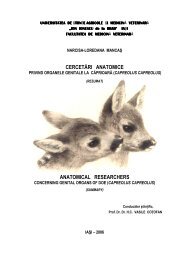
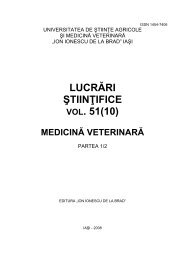
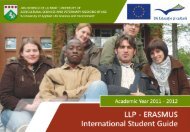
![rezumat teză [RO]](https://img.yumpu.com/19764796/1/190x245/rezumat-teza-ro.jpg?quality=85)
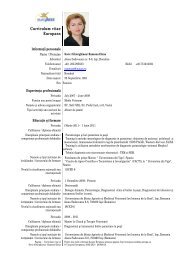



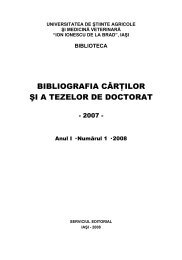
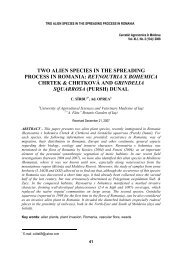
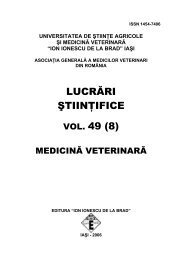
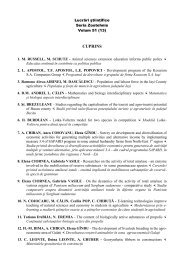
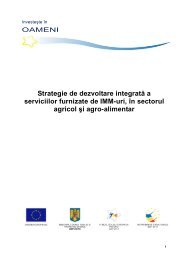
![rezumat teză [RO] - Ion Ionescu de la Brad](https://img.yumpu.com/14613555/1/184x260/rezumat-teza-ro-ion-ionescu-de-la-brad.jpg?quality=85)
